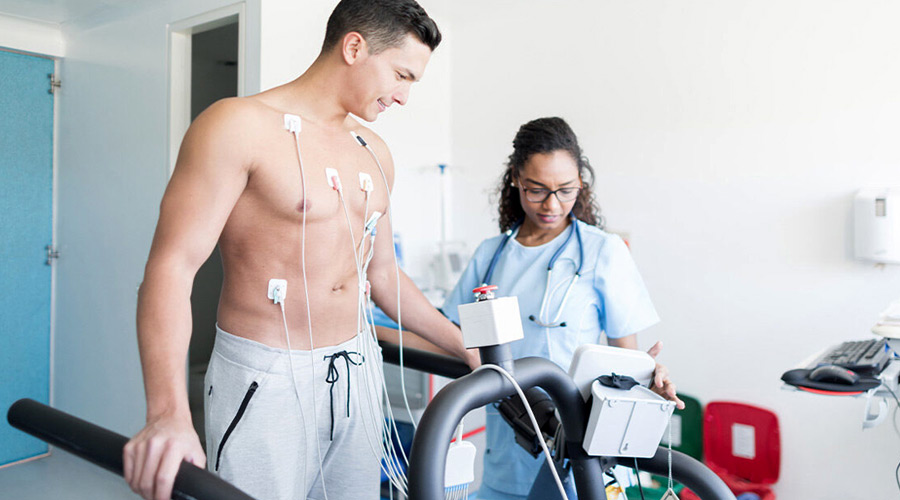
Treadmill Test (TMT)

Treadmill Test (TMT)
A Treadmill Test, also known as a Treadmill Stress Test, Exercise Stress Test, or Exercise Electrocardiogram (ECG), is a diagnostic test used to evaluate the heart's response to physical stress or exercise. It is commonly used to assess cardiac function, detect and diagnose heart-related problems, and evaluate a person's risk of heart disease or related conditions.
Here's how a Treadmill Test works:
Purpose: The primary goal of a Treadmill Test is to evaluate how well the heart responds to increased demands for oxygen and blood flow during exercise. It helps diagnose and assess various heart conditions, including coronary artery disease (CAD), arrhythmias, and cardiomyopathies.
Procedure:
-
Preparation: Before the test, the patient is typically evaluated by a healthcare provider, and their medical history, current medications, and any symptoms are reviewed. The patient may be asked to refrain from eating, drinking, or smoking for a specific period before the test. They should wear comfortable clothing and athletic shoes.
-
Electrode Placement: The patient's chest, arms, and legs are typically attached to electrodes that monitor the heart's electrical activity (ECG or EKG) throughout the test.
-
Baseline Measurements: Resting blood pressure and ECG readings are taken while the patient is at rest.
-
Treadmill Exercise: The patient then walks or runs on a motorized treadmill, which gradually increases in speed and incline (if applicable). The goal is to reach and sustain a target heart rate based on the person's age and physical condition.
-
Monitoring: During the test, the patient's heart rate, blood pressure, ECG, and any symptoms (e.g., chest pain, shortness of breath) are continuously monitored by healthcare professionals. The patient is encouraged to report any discomfort or symptoms.
-
Test Termination: The test may be stopped for various reasons, including reaching the target heart rate, development of symptoms, abnormal ECG changes, or patient fatigue.
-
Recovery: After the exercise phase, the patient continues to walk slowly or stands quietly for a few minutes while vital signs and ECG readings are monitored.
Interpretation:
The results of the Treadmill Test are evaluated by a healthcare provider, usually a cardiologist. Key findings that may be assessed include:
-
Exercise Capacity: How well the patient tolerated the exercise and how long they were able to continue.
-
Heart Rate Response: Whether the heart rate increased appropriately with exercise.
-
Blood Pressure Response: How blood pressure changed during exercise.
-
ECG Changes: Any abnormal ECG changes, such as ST-segment depression, which can indicate reduced blood flow to the heart muscle (ischemia).
-
Symptoms: Any symptoms experienced during the test, such as chest pain or shortness of breath.
Uses of Treadmill Tests:
- Diagnosis of coronary artery disease (CAD).
- Assessment of exercise tolerance and cardiovascular fitness.
- Evaluation of the effectiveness of heart medications or interventions.
- Identification of arrhythmias triggered by exercise.
- Determination of risk for future cardiac events.
- Monitoring patients with known heart disease.
- Clearance for physical activity or exercise programs.
Treadmill Tests are a valuable tool in cardiology and are typically performed in a controlled medical setting with trained healthcare professionals to ensure patient safety. The results of the test can provide important information for diagnosing and managing heart-related conditions.